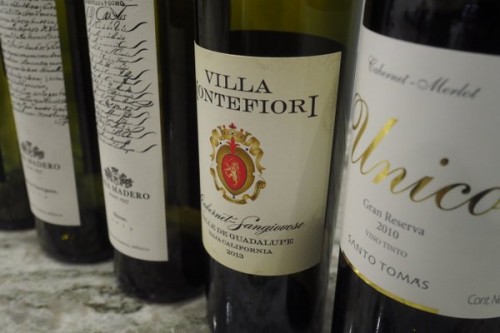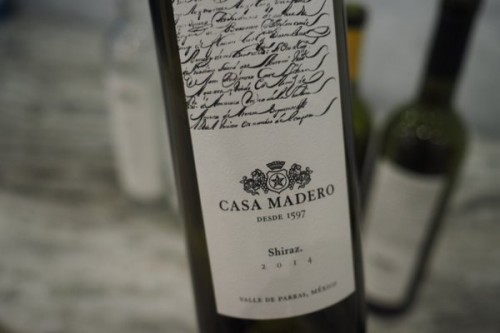
Serafin Alvarado and Wayne Belding presented this seminar on Mexican wines, a subject I’ve virtually no experience of.
Mexico isn’t an obvious place to grow high quality wine grapes: it’s a warm country at a latitude of 30 degrees north. There’s very little wine grown at these latitudes in the northern hemisphere, but the key thing for Mexico’s wine regions is the moderation of the warm climates by either altitude of cold coastal currents.
90% of Mexico’s wine production is in Baja California, but grapes are also grown along the Central Plateau. These are high elevation sites at around 6000 feet and above. In the Baja, it’s the cold water currents that moderates the climate.
Wine first came here in 1521, so this is the birthplace of wine in America. In 1699 wine was banned here because the Spanish had a surplus and wanted the colonies to drink Spanish wine. There was a concession for the church to carry on producing wine, though.
In 1857 there was the war of reform, and the government seized the assets of the church, confiscating all the land.
Phylloxera hit Mexico at the turn of the 20th century. Shortly after the Molokans arrived as refugees and they brought a lot of agricultural skill with them.
The Mexican revolution in 1910 was a huge set back. It wasn’t until 1972 that Casa Pedro Domecq began operating that things really began to come back in terms of wine production.
2014 figures show Mexico made 2.15 million cases (19.4 million litres) of which just 130 000 cases were exported. Imports were 6 million cases. A lot of grapes are grown, though, but most are for raisins, table grapes, or brandy. There are around 6200 acres of wine grapes and 100 000 acres of vineyards altogether.
There are a wide variety of grapes grown. Nothing dominates. Cabernet, Zinfandel, Merlot and Chardonnay are quite widely grown, but there are no star varieties here, which has made it hard to market Mexican wines because of the lack of identity.
Tax is a challenge: there’s a 40% tax on wine in Mexico. There are around 200 wineries in the country, and domestic consumption of wine is increasing, although it’s very low at the moment (0.4 litres per annum per capita).
Casa Madero Chenin Blanc 2016 Valle de Parras, Coahuila, Mexico
This is distinctive. It’s quite nutty and waxy with some compact pear and green apple fruit. It’s smooth and quite clean with fruit focus. Very waxy, with a slight plastic hint. I wouldn’t have spotted this as Chenin. 84/100
Monte Xanic Sauvignon Blanc ‘Viña Kristel’ 2016 Valle de Guadalupe, Baja California, Mexico
A newer producer established in 1987, with a technological winery. Fresh, clean wine with attractive fruit. It has a little bit of grassiness, but it’s very rounded and fruity. A little neutral, but really well made. Some tropical notes. 86/100
Casa Madero Chardonnay 2016 Valle de Parras, Coalhuila, Mexico
Attractive and clean with rich pear and white peach fruit. Fruit focused with moderate acidity and an attractive texture. No obvious oak here. A touch of waxiness, too. Not exciting, but well made. 87/100
Emevé Merlot Cabernet Franc Shiraz ‘é Amonía de Tintos’ 2015 Valle de Guadalupe, Baja California, Mexico
Minty and bold with sweet, ripe, dense fruit. Lush and chocolatey, with slightly jammy fruit and some intrusive cedary, minty oak. Very ripe and sweet. Forced, with too much ripeness and too much winemaking imprint. 83/100
Casa Madero Cabernet Sauvignon 2014 Valle de Parras, Coahuila, Mexico
Sweet and warm with some raisined, slightly jammy notes to the berry fruits. Some spice and earth hints. A bit oxidative. Not terrible, but not very inspiring. 82/100

Casa Madero Shiraz 2014 Valle de Parras, Coalhuila, Mexico
Supple and sweetly fruited with a mid-weight palate, some leathery hints and nice pure plum and blackberry fruit. Nicely balanced, with a savoury edge to the beautifully judged fruit. It’s ripe, for sure, but there’s restraint and digestibility here. It’s a proper wine. 89/100
Villa Montefiori Cabernet Sauvignon Sangiovese 2013 Valle de Guadalupe, Baja California, Mexico
Sweet, primary, floral, liqueur-like cherry fruit nose. Modern, primary fruit on the palate. It’s sweet and ripe and very commercial with lush yet quite fresh primary cherry and berry fruit. A wine of style, made in a very modern mould. 86/100
Bodegas de Santo Tomás Cabernet Sauvignon Merlot ‘Unico’ Gran Reserva 2010 Baja California, Mexico
Concentrated and spicy with a strong oak imprint. Dense and sweet with sweet, ripe berry fruit flavours and lots of cedar spice. Warm and rounded, and quite polished, but in a ripe, oaky style. It’s well done in its style, but seems quite old-fashioned. Trying to emulate the ripe, oaky Spanish style. 87/100
Find these wines with wine-searcher.com
Leave a Comment on Texsom: exploring the wines of Mexico

